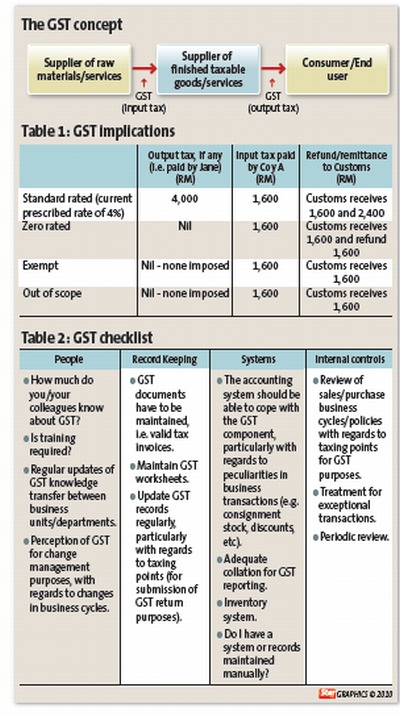GOODS and services tax (GST) is the tax that everyone is talking
about but is probably the most misunderstood tax in this current
economic climate. The deferment of GST caused ripples in the current
climate. Where does GST go from here? Has the tax been shelved or will
GST be implemented in the next two years? Will the consumer ever get to
see “inclusive of GST” on a price tag in Malaysia? Is this another
setback for GST?
Statements that begin as questions and are replied with more
questions – are the taxpayers ready for a replacement consumption tax?
Is the rakyat aware of the GST mechanism and its implications? Is
it a fairer and more transparent tax system compared with the existing
sales and service tax regime?
Going back to the basics, GST is a broad based consumption tax that will replace the existing sales and service taxes (see chart).
The concept of GST allows a self-policing mechanism for collection of
taxes, which should result in lower leakages and a lowering of other
direct taxes in the future. It is a transaction-based tax, which
requires regular submission of both tax returns and remittances of the
taxes collected. Such a mechanism allows for refunds to be issued in a
more efficient manner, as the monies due to taxpayers (when the output
taxes paid are lower than the input taxes paid) are already in the
coffers of the Royal Malaysian Customs, due to the regular remittances
made by GST registered entities.
Goods and services are either subject to GST (taxable) or not (non
taxable). For taxable goods and services, there are two rates of GST
that can be imposed, i.e. standard rate (current prescribed rate to be
imposed is 4%) and zero rate. For non-taxable goods and services, there
are two categories to be considered, i.e. exempt and ‘out of scope’. In
both categories of non-taxable goods and services, no GST (i.e. output
tax) is imposed and no GST (i.e. input tax) can be claimed.
GST in action
In order to illustrate the different GST implications based on the
various categories, we have used arbitrary figures in the example below.

Company A manufactures, develops and sells finished products to
consumers. GST considerations have to be made with regards to the
supplies/raw materials acquired to manufacture/develop (value-added
activity), together with the GST (if any) to be imposed on the selling
price to the customer.
Jane acquires a finished product of RM100,000 and Company A acquires
supplies/raw materials (taxable supplies) for RM40,000 and pays its
suppliers, RM41,600 (GST component – input tax of RM1,600).
We have outlined the GST implications based on the different categories in Table 1.
Is the rakyat aware of the GST mechanism and its implications? Are they ready?
Further to the Second Finance Minister’s statement (March 13, 2010)
in respect of the deferment of the reading of the draft GST bill, a
point to note is the concern of the “readiness” of the rakyat of this new tax. How many people actually understand the mechanism and impact of GST?
GST is a transparent tax, where there is no cascading effect akin to
what is currently experienced with the existing sales and service tax
(‘hidden taxes’ borne by the consumer). However, due to lack of
awareness and understanding of the GST mechanism, implementation of such
a tax could present some challenges.
Does it really take 12 to 18 months for a business entity to get
ready to be able to cope in a GST environment? Generally, the time
required for a GST implementation exercise varies from business entity
to entity, with regards to the existing infrastructure, volume of
business transactions, peculiarities of the business itself as well as
how efficient the GST knowledge transfer is executed.
A bird eye’s view of considerations to be made with regards to how ready you are for GST is outlined in Table 2. Even though GST is a tax, it impacts all operations of a business.
The list of considerations outlined in Table 2 is not
exhaustive. Please note that the “GST readiness” for each entity would
vary based on type of business, GST awareness, infrastructure, etc. We
hope that the above checklist can provide some assistance to businesses,
in terms of determining how ready they may or may not be for a GST
environment.
The extension of time or rather deferment of GST can be viewed as
being practical, in terms of enabling more taxpayers to educate and
better prepare themselves for the impending GST environment. A smooth
transition into a new climate is possible, provided steps are taken
based on the requirements of an entity (i.e. depending on how “GST
ready” they are). Therefore, taking measures to take stock of your
position in relation to GST, should be taken now to enable planning for
the implementation exercise.
“To think too long about doing a thing often becomes its undoing”.
The introduction of GST as a replacement tax and its deferred reading at
parliament, really allows more time for the rakyat to get ready.
However, the clock starts ticking now and the additional time only
becomes useful, if actions are taken now to determine the timelines and
implementation exercise to be executed.

